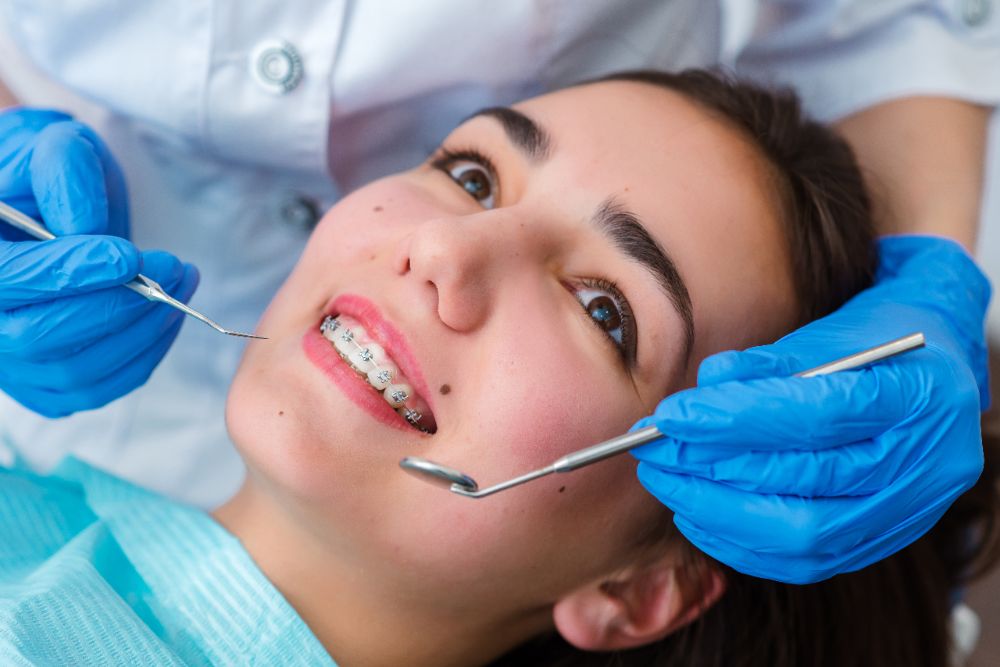Professional Cumming Braces and Aligners: What to Know Prior To You Check out
Wiki Article
Comprehensive Guide to Orthodontics Treatments for Remedying Dental Imbalances
In the realm of orthodontics, the journey to accomplishing a perfectly straightened smile includes a myriad of treatments tailored to deal with dental imbalances. From standard braces to unseen aligners and also medical options, the area of orthodontics offers a series of solutions to attend to varying levels of dental abnormalities. Understanding the ins and outs of each procedure, including their systems, advantages, and potential disadvantages, is essential in making educated decisions regarding one's orthodontic therapy. As we navigate with the thorough overview to orthodontic procedures for dealing with dental misalignments, the complex information of each method will certainly unravel, dropping light on the course towards a practical and unified dental positioning.Orthodontic Procedures Review

In addition to clear aligners and traditional dental braces, orthodontists might likewise suggest other treatments like headwear, palatal expanders, or retainers to deal with certain positioning issues (cumming aligners). These treatments are tailored to each person's special needs and might include a combination of therapies to accomplish the desired outcomes. Regular changes and tracking are crucial components of orthodontic treatment to ensure progression gets on track and to make any kind of essential adjustments along the road. By undergoing orthodontic treatments, patients can not just achieve a straighter smile but additionally enhance their total oral wellness and function.
Traditional Braces: Just How They Work
When considering orthodontic treatments for dental misalignments, traditional braces stand apart as a time-tested method for fixing teeth positioning. Conventional braces consist of brackets, cords, and bands that collaborate to use constant pressure on the teeth, slowly moving them into the wanted placement. The braces are connected to the teeth utilizing a special adhesive, and the wires are threaded through the brackets. By changing the tension of the cords, orthodontists can regulate the direction and force put on each tooth, guiding them into correct positioning in time.
As pressure is used to the teeth through the braces, the bone bordering the teeth is reshaped to sustain the new tooth positions. Clients will require normal modifications at the orthodontist's workplace to guarantee the braces proceed to use the appropriate stress for reliable teeth movement.
Undetectable Aligners: Benefits And Drawbacks
These clear, customized trays are practically unnoticeable when used, making them an attractive choice for individuals seeking a more aesthetically pleasing orthodontic treatment. Patients can get rid of the aligners prior to consuming or brushing their teeth, decreasing the risk of food getting stuck in the device and streamlining the cleansing process.
Surgical Orthodontic Options
Surgical treatments in orthodontics present sensible choices for dealing with intricate dental imbalances that may not be successfully resolved with standard orthodontic treatments. While unnoticeable aligners and standard braces can deal with many orthodontic issues, specific instances call for surgical intervention to accomplish ideal outcomes. Surgical orthodontic options are commonly recommended for severe malocclusions, considerable jaw inconsistencies, and instances where the underlying bone framework requires alteration to achieve proper placement.One typical medical orthodontic treatment is orthognathic surgical procedure, which entails rearranging the jaws to correct functional issues such as difficulty talking or eating. This surgical treatment is usually executed in cooperation with an orthodontist that aids straighten the teeth prior to and after the procedure. Surgical orthodontics may likewise involve procedures to reveal influenced teeth, get rid of excess periodontal tissue, or reshape the jawbone to create an extra unified face profile.
Before considering medical orthodontic choices, individuals go through an extensive evaluation to identify the necessity and possible advantages of such interventions. orthodontist. While surgical procedure might seem daunting, it can significantly boost both the function and aesthetic appeals of the smile in cases where standard orthodontic treatments fail
Retainers and Post-Treatment Treatment

Post-treatment treatment entails following the orthodontist's directions vigilantly. This may include appropriate oral hygiene techniques, going to follow-up consultations, and wearing the retainers as suggested. Failure to follow post-treatment treatment directions can cause regression, where the teeth slowly return towards their original settings. Constant retainer wear, great dental health, and normal dental check-ups are crucial for maintaining the results accomplished through orthodontic surgical procedure and making certain the long-term stability of the dealt with oral positioning.
Final Thought
To conclude, orthodontic procedures provide different choices for correcting oral misalignments. Standard braces utilize metal brackets and wires to move teeth into appropriate positioning. Unnoticeable aligners offer an even more very discreet option yet may not appropriate for all situations. Surgical orthodontic alternatives are available for a lot more serious imbalances. Retainers are generally utilized post-treatment to keep the new alignment. In general, orthodontic procedures can properly enhance dental health and visual appearance.As we navigate through the comprehensive guide to orthodontic treatments for correcting oral misalignments, the intricate information of each approach will certainly unravel, dropping light on the course towards a practical and unified oral positioning. - invisalign
One of the most common orthodontic therapies is the use of braces, which are composed of metal braces and cables that use mild pressure to slowly shift teeth right into the desired placement.When thinking about orthodontic therapies for dental imbalances, conventional dental braces stand out as a tried and true approach for correcting teeth placing. Furthermore, unnoticeable aligners may not be suitable for intricate orthodontic problems that call for even more considerable teeth activity, as they are normally advised for light to moderate situations. Retainers are tailor-made orthodontic tools developed to hold teeth in their remedied placements after the completion of orthodontic therapy.
Report this wiki page